Effects of heat treatment parameters and grain sizes on mechanical response of amorphous/crystalline CuZr composites
IF 3.4
3区 材料科学
Q2 MATERIALS SCIENCE, MULTIDISCIPLINARY
引用次数: 0
Abstract
The amorphous phase proportion in nanocrystalline/amorphous CuZr samples was tailored using heat treatment processes under a fast-dynamic regime by varying temperature and time. It was revealed that using molecular dynamics simulations of tension tests, the samples with a larger fraction of crystalline phase exhibit superior mechanical properties. During tension, a dual-slope phenomenon was observed, driven by grain boundary behaviors and subsequent phase transition in the crystalline phase. The plastic deformation was mainly dominated by slip bands generated from dislocation nucleation in the crystalline phase, rather than embryonic shear bands in the amorphous phase. In contrast, the samples with a higher fraction of amorphous phase exhibit softening, leading to reduced mechanical properties. Plastic deformation in these samples is initiated by shear band nucleation in the amorphous phase, which expands within the amorphous phase and induces the formation of slip bands in the crystalline phase, though deformation remains predominantly governed by shear bands. These results can provide insight into the deformation behavior of nanoscale amorphous/crystalline dual-phase CuZr composites and guidance for the structural optimization of high-strength and high-plasticity amorphous/crystalline composites.
热处理参数和晶粒尺寸对非晶/结晶CuZr复合材料力学响应的影响
采用快速动态热处理工艺,通过改变温度和时间来调整CuZr纳米晶/非晶样品的非晶相比例。通过分子动力学模拟拉伸试验发现,晶相含量较高的试样具有较好的力学性能。在拉伸过程中,观察到由晶界行为和随后的晶相相变驱动的双斜率现象。塑性变形主要以晶态位错形核产生的滑移带为主,而非晶态的胚胎剪切带为主。相反,非晶相含量较高的样品表现出软化,导致力学性能下降。这些样品的塑性变形是由非晶相中的剪切带形核引发的,剪切带在非晶相中扩展,并在晶相中诱发滑移带的形成,尽管变形仍然主要由剪切带控制。这些结果可以为深入了解纳米级非晶/晶双相CuZr复合材料的变形行为,为高强高塑性非晶/晶复合材料的结构优化提供指导。
本文章由计算机程序翻译,如有差异,请以英文原文为准。
求助全文
约1分钟内获得全文
求助全文
来源期刊

Mechanics of Materials
工程技术-材料科学:综合
CiteScore
7.60
自引率
5.10%
发文量
243
审稿时长
46 days
期刊介绍:
Mechanics of Materials is a forum for original scientific research on the flow, fracture, and general constitutive behavior of geophysical, geotechnical and technological materials, with balanced coverage of advanced technological and natural materials, with balanced coverage of theoretical, experimental, and field investigations. Of special concern are macroscopic predictions based on microscopic models, identification of microscopic structures from limited overall macroscopic data, experimental and field results that lead to fundamental understanding of the behavior of materials, and coordinated experimental and analytical investigations that culminate in theories with predictive quality.
 求助内容:
求助内容: 应助结果提醒方式:
应助结果提醒方式:


